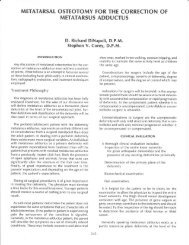lateral pain syndromes of the foot and ankle - The Podiatry Institute
lateral pain syndromes of the foot and ankle - The Podiatry Institute
lateral pain syndromes of the foot and ankle - The Podiatry Institute
You also want an ePaper? Increase the reach of your titles
YUMPU automatically turns print PDFs into web optimized ePapers that Google loves.
concerned about tendinosis. Conservative treatments are<br />
rarely helpful for tendinosis <strong>and</strong> will generally require a<br />
surgical intervention.<br />
<strong>The</strong>re is a favorable prognosis with conservative<br />
treatment for peroneal tendinitis that generally will include<br />
some combination <strong>of</strong> anti-inflammatory medication,<br />
immobilization, physical <strong>the</strong>rapy, <strong>and</strong> orthoses. A word <strong>of</strong><br />
caution with cortisone injections is prudent in peroneal<br />
pathology. One may consider a cortisone injection into <strong>the</strong><br />
cubital tunnel for localized <strong>pain</strong> that does not respond to<br />
o<strong>the</strong>r treatments. <strong>The</strong> injection into <strong>the</strong> cubital tunnel is<br />
inferior to <strong>the</strong> peroneus brevis tendon. For o<strong>the</strong>r areas<br />
along <strong>the</strong> course <strong>of</strong> <strong>the</strong> tendons, unless <strong>the</strong> patient will be<br />
immobilized, I will not consider a cortisone injection.<br />
I have seen too many tendon ruptures in this area after<br />
cortisone injections (Figures 3 <strong>and</strong> 4).<br />
SINUS TARSI SYNDROME<br />
This is one <strong>of</strong> those disorders that nobody really knows exactly<br />
what it is, but it can be successfully treated.<br />
Diagnosis <strong>of</strong> sinus tarsi syndrome is straight forward. When<br />
<strong>the</strong>re is <strong>pain</strong> in <strong>the</strong> sinus tarsi on palpation <strong>and</strong> symptoms<br />
resolve after injection <strong>of</strong> local anes<strong>the</strong>tic, one can be<br />
confident with <strong>the</strong> diagnosis even without fur<strong>the</strong>r testing.<br />
Certainly radiographic evaluation is necessary to assess for<br />
advanced arthritis <strong>of</strong> <strong>the</strong> subtalar joint. MRI can be done<br />
to exclude o<strong>the</strong>r pathologies. My personal opinion is that<br />
sinus tarsi syndrome is a synovitis whe<strong>the</strong>r it is a chronic<br />
condition caused by mechanical influences <strong>of</strong> <strong>the</strong> pes valgus<br />
<strong>foot</strong> type or some kind <strong>of</strong> acute inversion injury.<br />
Instability <strong>of</strong> <strong>the</strong> subtalar joint has been postulated as<br />
Figure 3. Clinical view <strong>of</strong> <strong>the</strong> area <strong>of</strong> <strong>the</strong> <strong>foot</strong> that cortisone should be<br />
avoided (danger zone) <strong>and</strong> a safe area for cortisone in <strong>the</strong> cubital tunnel<br />
(OK). <strong>The</strong> dashed line represents <strong>the</strong> peroneal tendon course.<br />
CHAPTER 3 15<br />
a source <strong>of</strong> apparent <strong>ankle</strong> instability. If <strong>the</strong>re is disruption<br />
<strong>of</strong> <strong>the</strong> talocalcaneal ligaments <strong>and</strong> <strong>the</strong> cervical ligament,<br />
<strong>the</strong>n it seems likely that like <strong>the</strong> <strong>ankle</strong>, this can contribute<br />
to instability. It is difficult to make a clinical call on<br />
subtalar joint instability. Stress testing <strong>of</strong> <strong>the</strong> subtalar joint<br />
is difficult to do without influence <strong>of</strong> <strong>the</strong> <strong>ankle</strong> joint. My<br />
personal opinion is that if <strong>the</strong> talar tilt test is equivocal <strong>and</strong><br />
<strong>the</strong> anterior drawer test is positive for laxity, <strong>the</strong>n it is<br />
generally <strong>ankle</strong> ligament instability. Conversely, if <strong>the</strong><br />
anterior drawer test seems normal <strong>and</strong> <strong>the</strong> talar tilt test is<br />
not, <strong>the</strong>n subtalar joint instability may be playing a role.<br />
We know that in <strong>ankle</strong> sprains, it would be unlikely that<br />
<strong>the</strong> calcane<strong>of</strong>ibular ligament ruptures leaving an intact<br />
anterior tal<strong>of</strong>ibular ligament.<br />
If instability <strong>of</strong> subtalar joint plays a clinical role, <strong>the</strong>n<br />
why aren’t <strong>the</strong>re reports <strong>of</strong> instability following sinus tarsi<br />
decompressions that involve excision <strong>of</strong> <strong>the</strong> entire contents<br />
including <strong>the</strong> ligaments? It would seem likely that<br />
everybody who had a sinus tarsi decompression would<br />
have symptoms <strong>of</strong> instability postoperatively, however that<br />
does not seem to be <strong>the</strong> case.<br />
Treatment <strong>of</strong> sinus tarsi syndrome will typically<br />
involve oral anti-inflammatory medications, cortisone<br />
injections, physical <strong>the</strong>rapy, <strong>and</strong>/or biomechanical control<br />
with orthotic devices. In cases <strong>of</strong> arthritis, subtalar<br />
arthrodesis may be necessary. Sinus tarsi decompression<br />
may be <strong>of</strong> benefit in recalcitrant cases. In confirmed<br />
instability <strong>of</strong> <strong>the</strong> subtalar joint, a split peroneus longus<br />
tenodesis <strong>ankle</strong> stabilization procedure may be a good<br />
approach as <strong>the</strong> 2-ligament repair will also cross <strong>the</strong><br />
subtalar joint. <strong>The</strong>refore, both <strong>the</strong> <strong>ankle</strong> <strong>and</strong> subtalar joints<br />
are stabilized.<br />
Figure 4. Intraoperative view that depicts a partial rupture <strong>of</strong> <strong>the</strong><br />
peroneus brevis tendon. <strong>The</strong>re is calcification within <strong>the</strong> tendon. This<br />
patient had prior cortisone injections in this area.

















